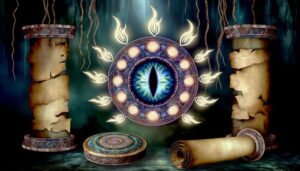What Is the Sage of Six Paths Symbol’s Meaning?
The Sage of Six Paths symbol, deeply rooted in the Naruto series, epitomizes the legendary figure Hagoromo Ōtsutsuki. It integrates elements of ultimate wisdom and power, symbolized by a six-tomoe motif encircling a Rinnegan eye.
Beyond its visual design, the symbol conveys profound themes of balance, unity, and enlightenment. Hagoromo's teachings on chakra and Ninshū profoundly shaped the ninja world, fostering peace and understanding.
The colors and shapes used in the symbol denote spiritual and philosophical depths, from cycles of life to cosmic order. Insights into its rich background further reveal its significance in the narrative.
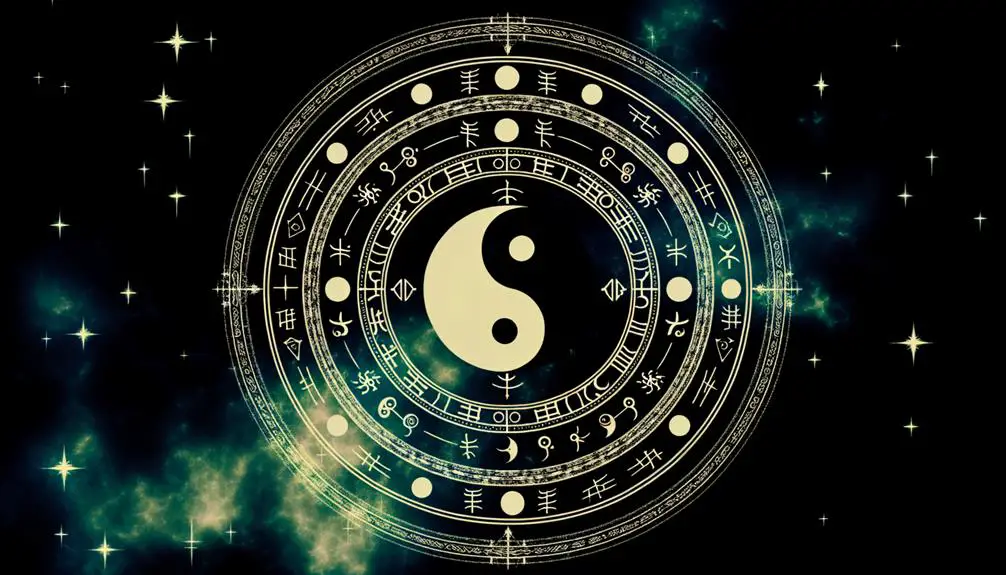
Key Takeaways
- Represents ultimate wisdom and power, symbolized by the six-tomoe motif around a Rinnegan eye.
- Signifies the integration of spiritual and physical domains within the ninja world.
- Embodies the principles of balance, unity, and enlightenment.
- Reflects the cyclical nature of power, rebirth, and the duality of forces.
- Portrays the Sage's legacy of promoting peace and moral integrity among humanity.
Origins of the Symbol

The origins of the Sage of Six Paths symbol can be traced back to ancient mythological narratives within the Naruto series, where it serves as a pivotal emblem representing the legendary figure Hagoromo Ōtsutsuki and his profound influence on the ninja world.
This symbol, often depicted as a six-tomoe motif encircling a Rinnegan eye, is deeply rooted in the lore of chakra and ninjutsu. It symbolizes Hagoromo's role in disseminating chakra and the foundational principles of ninjutsu to humanity.
Analyzing this emblem within the context of Naruto's mythology reveals its significance as a mark of ultimate wisdom, power, and the unification of spiritual and physical energies, embodying the core tenets that underlie the series' narrative structure.
Hagoromo Ōtsutsuki's Legacy
Hagoromo Ōtsutsuki, revered as the Sage of Six Paths, fundamentally shaped the ninja world by introducing the concept of chakra, which became the cornerstone of all shinobi abilities.
His teachings and philosophies laid the groundwork for the establishment of ninjutsu, influencing countless generations of shinobi.
Creation of Ninja World
Frequently hailed as a pivotal figure in the history of shinobi, Hagoromo Ōtsutsuki's contributions to the formation of the ninja world are both profound and far-reaching.
As the originator of Ninshū, he established the foundational principles that would develop into contemporary ninjutsu. By spreading his teachings about chakra, he aimed to promote peace and understanding among humanity.
His creation of various spiritual doctrines and practices provided a coherent framework for the emerging ninja society. The sealing of the Ten Tails and the subsequent splitting of its chakra into the tailed beasts further demonstrate his strategic and philosophical foresight.
His legacy, hence, is not just in techniques but in the enduring ethos of balance and harmony he aimed to impart.
Origin of Chakra
Building upon his profound influence on the ninja world, Hagoromo Ōtsutsuki's legacy is most distinguishedly marked by the introduction and dissemination of chakra, fundamentally altering the course of human capability and interaction.
As the progenitor of chakra, Hagoromo harnessed its potential through rigorous spiritual and physical discipline, eventually sharing this knowledge with humanity. His teachings enabled individuals to mold chakra into ninjutsu, genjutsu, and other diverse applications, thereby laying the foundation for modern ninja practices.
This transformative power of chakra not only expanded human potential but also created a shared spiritual and energetic connection among people. By ensuring these latent abilities, Hagoromo's legacy cemented that chakra became the cornerstone of both individual prowess and collective societal advancement.
Influence on Shinobi
As the originator of many foundational practices in the ninja world, Hagoromo Ōtsutsuki's influence on shinobi extends far beyond the mere introduction of chakra, encompassing the establishment of ethical guidelines and the moral use of power. By sharing his wisdom and teachings, Hagoromo laid the groundwork for a society where power was balanced with responsibility.
His creation of Ninshū promoted the idea of spiritual connection and understanding among people, distinct from the combative nature of Ninjutsu. These teachings fostered a sense of unity and purpose among shinobi, encouraging them to use their abilities for the greater good.
Hagoromo's legacy persists not only in the physical capabilities of shinobi but also in the ethical frameworks guiding their actions.
Design Elements Explained
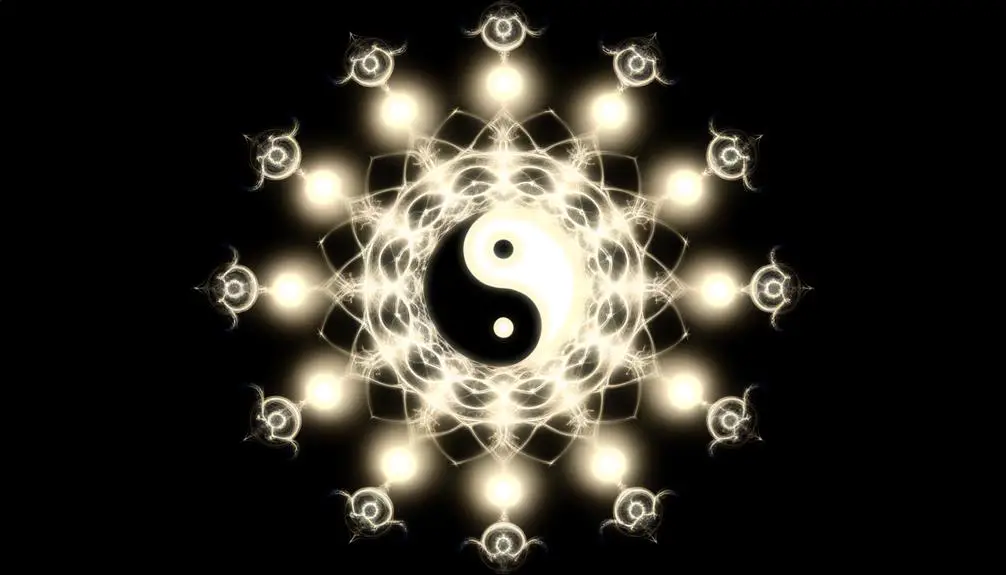
To fully understand the Sage of Six Paths symbol, one must consider the intricate design elements that it encompasses.
The color scheme employed is not merely aesthetic but holds profound significance, reflecting the philosophical and spiritual ideals of Hagoromo Ōtsutsuki.
Additionally, the symbolic geometric shapes and iconic visual motifs within the symbol provide deeper insight into its esoteric meanings and narrative context.
Color Scheme Significance
The color scheme of the Sage of Six Paths symbol is intricately designed to convey profound spiritual and philosophical meanings, reflecting the duality and balance inherent in its lore. Each hue is carefully selected to represent various aspects of the Sage's teachings and the broader universe.
- Black: Signifies the void, infinite potential, and the unknown, embodying the concept of yin.
- White: Represents purity, enlightenment, and the known, symbolizing the yang in balance with black.
- Gold: Illustrates divinity, wisdom, and the transcendence of the Sage.
- Red: Conveys life force, energy, and the energy of creation.
- Blue: Reflects tranquility, spiritual depth, and the connection to the divine.
These colors together create a harmonious representation of the Sage's profound and balanced vision.
Symbolic Geometric Shapes
Geometric shapes within the Sage of Six Paths symbol, such as the concentric circles and symmetrical patterning, serve as profound representations of cosmic order and philosophical principles central to its lore. The meticulously arranged circles signify unity and the cycles of life, echoing the balance and harmony foundational to the Sage's teachings. Meanwhile, the symmetry embodies the duality and equilibrium present in the universe, suggesting a deeper metaphysical balance.
| Shape | Symbolic Meaning |
|---|---|
| Concentric Circles | Unity and cycles of life |
| Symmetrical Patterns | Duality and universal equilibrium |
| Triangular Forms | Trifecta of mind, body, and spirit |
| Lines and Angles | Direction and purposeful movement |
| Overlapping Shapes | Interconnectedness of all things |
Understanding these elements provides a window into the profound spiritual and philosophical tenets of the Sage of Six Paths.
Iconic Visual Motifs
Frequently, the Sage of Six Paths symbol incorporates iconic visual motifs that are deeply rooted in cultural and mythological contexts, offering rich layers of meaning and interpretation. These design elements are not arbitrary but are carefully chosen to represent various philosophical and spiritual concepts.
Key motifs include:
- Rinnegan Eye: Symbolizes enlightenment and the ability to perceive deeper truths.
- Tomoe Patterns: Often three in number, these signify unity, balance, and the cyclical nature of life.
- Yin-Yang Symbols: Reflects duality and the balance between opposing forces.
- Six Circles: Represent the six paths or domains of existence, each with distinct characteristics.
- Staff and Beads: Denote the sage's wisdom and spiritual authority.
These elements collectively convey a profound narrative that resonates with followers and scholars alike.
Symbolism in Naruto Lore
Symbolism in Naruto Lore intricately weaves together cultural references, mythological elements, and character development to create a rich tapestry that enhances the narrative's depth and emotional resonance.
For instance, the Rinnegan, a dōjutsu possessed by the Sage of Six Paths, draws inspiration from Hindu-Buddhist deities' eyes, symbolizing enlightenment and divine authority.
Additionally, the Tailed Beasts, known as Bijū, embody aspects of Japanese folklore's mythical creatures, reinforcing the series' thematic exploration of power and control.
Characters' journeys often mirror classic hero archetypes, reflecting their internal struggles and growth.
These symbolic layers not only offer a deeper understanding of the characters' motivations but also connect the fictional world of Naruto to broader cultural and mythological frameworks, enriching the viewer's engagement.
Unity and Power Themes
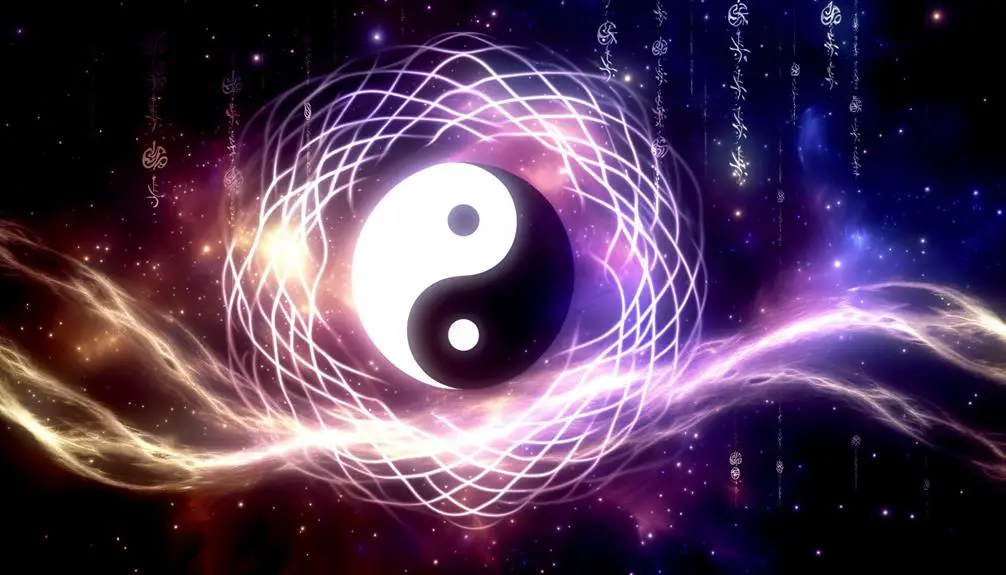
Expanding upon the intricate symbolism in Naruto lore, the themes of unity and power are epitomized through the Sage of Six Paths' legacy, reflecting the delicate balance between individual strength and collective harmony. This balance is manifested in various ways:
- Rinnegan Symbolism: Represents the convergence of power and wisdom.
- Creation of Ninshu: Aimed to foster peace through shared understanding.
- Hagoromo's Sons: Embody the struggle between peace and power.
- The Six Paths Technique: Illustrates the merging of spiritual and physical domains.
- Symbol of the Moon and Sun: Signifies the duality of forces working in tandem.
These themes underscore the Sage's vision for a harmonious world where power is wielded responsibly and unity is paramount.
The Balance of Forces
How does the intricate interplay between light and dark, good and evil, manifest within the complex paradigm of the Sage of Six Paths, reflecting the essential balance of forces in Naruto's universe?
The Sage of Six Paths, Hagoromo Ōtsutsuki, embodies this duality through his division of the Ten-Tails' chakra into nine distinct tailed beasts and the sharing of his own power between his sons, Asura and Indra. This act symbolizes the necessity of equilibrium, where neither force can wholly dominate. The symbol of the Rinnegan, representing cyclical nature and rebirth, further underscores this theme.
In the Naruto series, the balance of forces is not merely a philosophical construct but a foundational element that guarantees stability, peace, and continuity within the ninja world.
Impact on Characters
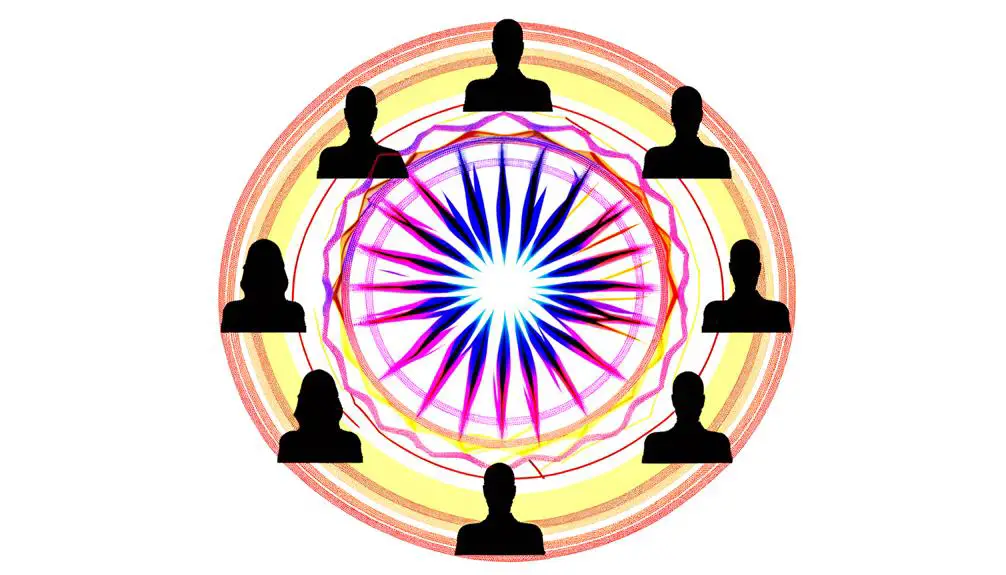
The influence of the Sage of Six Paths' legacy profoundly shapes the destinies of key characters in Naruto, illustrating the enduring impact of his principles and power across generations. This foundational figure's teachings and abilities resonate deeply within the narrative, guiding pivotal moments and character developments.
Naruto Uzumaki inherits the Sage's chakra and ideals, becoming a beacon of hope and unity.
Sasuke Uchiha grapples with the Sage's legacy, balancing power and morality.
Madara Uchiha seeks the Sage's power, aiming to impose his vision of peace.
Obito Uchiha is swayed by the Sage's mythos, driving his transformation and ambitions.
Hagoromo Ōtsutsuki directly influences the protagonists through his spiritual guidance, shaping their ultimate paths.
These characters exemplify the Sage's profound and multifaceted legacy.
Cultural Significance
Beyond individual character arcs, the Sage of Six Paths' symbol holds substantial cultural significance, embodying the principles of balance, unity, and enlightenment that permeate the Naruto universe. This symbol serves as a nexus for numerous cultural elements, reflecting the harmonious integration of spiritual and physical domains, and the pursuit of ultimate truth and wisdom. Within the Naruto series, the symbol is frequently connected to the founding ideologies of the ninja world, emphasizing moral integrity and the cyclical nature of power and peace.
| Principle | Representation | Contextual Reference |
|---|---|---|
| Balance | Yin-Yang | Chakra energy distribution |
| Unity | Six Paths | Unification of diverse powers |
| Enlightenment | Rinnegan | Ultimate spiritual awakening |
| Legacy | Sage's Teachings | Foundational ninja values |
This cultural matrix underscores the symbol's profound narrative significance.
Resonance With Fans
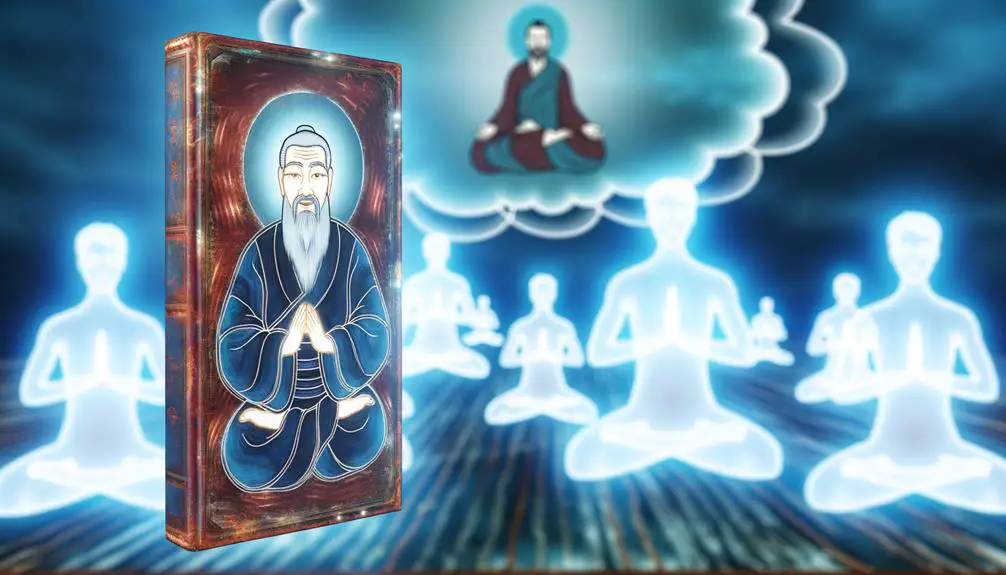
Enthralling the imagination of its audience, the Sage of Six Paths' symbol resonates deeply with fans, reflecting a multifaceted appreciation for its intricate narrative and philosophical layers. The symbol, integrated within the lore of the Naruto series, offers a profound connection that fans interpret in various meaningful ways:
- Spiritual Exploration: Represents a journey towards enlightenment and understanding of self.
- Narrative Depth: Symbolizes the rich and complex backstory of the series.
- Philosophical Inquiry: Encourages contemplation of themes such as duality and balance.
- Cultural Fusion: Blends elements of mythology, spirituality, and folklore.
- Character Development: Embodies the growth and transformation of key characters.
This resonance underscores the symbol's enduring impact, fostering a deeper engagement with the series' themes and narratives.
Conclusion
The Sage of Six Paths symbol, an emblem of unparalleled significance, epitomizes the intricate balance of power, unity, and legacy within the Naruto universe.
Its design elements and cultural resonance echo through the series, influencing characters and narratives profoundly.
With roots in Hagoromo Ōtsutsuki's legacy, the symbol serves as a beacon of monumental influence, embodying the eternal struggle and harmony of opposing forces.
Such a symbol's impact on fans and the storyline is nothing short of legendary.



